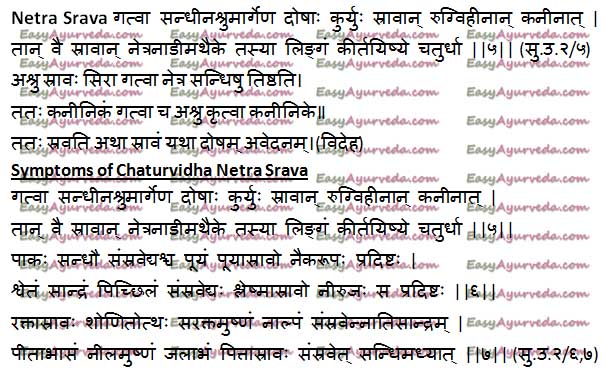Chaturvidha Netra Srava – 4 types of eye discharges, symptoms, treatment
Article by Dr Raghuram Y.S. MD (Ay) & Dr Manasa, B.A.M.S
Netra Srava means eye discharge. It is an eye disorder affecting the inner canthus. It is of 4 types as per Ayurveda and all the four are incurable.
Related reading – Netra Sandhi Gata Rogas
Table of Contents
4 types of Srava
Chaturvidha Srava – Quick look about the disease
Specific location – Kaneenika Sandhi – Inner Canthus of the Eye (meeting point of eye lids on the inner side of the eye)
Classification based on the location – Chaturvidha Sravas are Sandhigata Rogas i.e. diseases occurring in the junction of the eye
Classification based on Predominant Dosha –
- Puya Srava – is a sannipataja or sarvagata netra roga i.e. caused by simultaneous vitiation of all three doshas
- Shleshma Srava or Kaphaja Srava – is a kaphaja netra roga i.e. caused by vitiated kapha
- Raktaja Srava – is a Raktaja netra roga i.e. caused by vitiated rakta or blood
- Pittaja Jala Srava – is a pittaja netra roga i.e. caused by vitiated pitta
Classification based on Sadhya Asadhyata (prognosis) – all the four are incurable.

Pathogenesis
Chaturvidha Srava, pathogenesis, symptoms
The vitiated three doshas i.e. vata, pitta and kapha travel through the ashru margas (lacrimal or tear ducts) and reach the netra sandhis (junction of the eye).
On reaching the junctions of the eye (netra sandhi, kaneenika sandhi or inner canthus to be precise) and getting lodged therein, the vitiated doshas will cause discharges from the inner canthus of the eye without pain. These diseases wherein there is various discharges ocfuring from the inner canthus of the eye in different forms depending on the doshas involved are called Netra Srava. Netra Srava is also called as Netra Nadis.
Acharya Videha (and Yogaratnakara) too gives a similar opinion. According to these references, the doshas travelling through ashrusrava sira (lacrimal ducts or passages carrying tears) get lodged in the kaneenika sandhi (inner canthus of the eye) and produces many types of discharges according to the doshas involved. These conditions are called Netra Srava (eye discharges) and are not associated with pain.
Jalasrava – Acharya Vagbhata and Yogaratnakara mentions another type of srava i.e. Jalasrava. In this condition, the jala vahini siras (ducts or passages carrying the water or fluid) are blocked by the vitiated vayu. This causes continuous discharge of watery tears from the kaneenika sandhi or inner canthus. This is not associated with swelling or pain.
Symptoms
Symptoms of Chaturvidha Netra Srava
Netra Srava or discharges occurring from the junctions of the eye (inner canthus) are of 4 types. They are:
Puya Srava – Puya Srava is a condition in which suppuration occurs in the sandhi (inner canthus) of the eye. This will cause many types of puya srava or discharge of pus from the inner canthus.
Shleshma Srava – Shleshma srava is a condition in which white colored, thick, sticky and painless discharges occur from the inner canthus.
Rakta Srava – Rakta srava means bloody discharges or blood like or blood mixed discharges. In Rakta srava, the discharges occur due to vitiated blood. The discharges occur along with blood, are excessive in quantity, hot in touch and dilute in nature.
Pitta Srava – In Pitta Srava, yellowish blue watery discharges, hot on touch are discharged from the inner canthus of the eye.
Modern correlation
In all four types of Netra Srava, there are different types of discharges taking place from the kaneenika sandhi or inner canthus of the eye. Therefore, Chaturvidha Netra Srava can be grossly compared to ‘diseases of the lacrimal apparatus’.
In Puya Srava there is discharge of pus. Therefore it can be compared to purulent discharges from the eye.
In Shleshma Srava or Kaphaja Srava, there is mucus discharges from the eye. Therefore it can be compared to mucus discharges from the eye.
In Rakta Srava, there are bloody discharges from the eye. Therefore it can be compared to bleeding discharges from the eye.
In Pitta Srava, there is discharge of watery discharges which have weird colors. Therefore it can be compared with watery discharges from the eye.
All these conditions are said to be incurable by Sushruta.
Causes of eye discharge
One or more of the below mentioned causes may be involved in causation of netra sravas or eye discharges (mentioned above). They are –
- Eversion of the punctum (outward opening of the orifice of the lacrimal duct)
- Stenosis or occlusion of the punctum
- Obstruction of the canaliculus
- Stricture of the nasal duct
- Dacryocystitis
At the same time, later treatises, especially Yoga Ratnakara has mentioned useful formulations for effectively treating netra sravas i.e. eye discharges (even chronic and stubborn ones).
Click to Consult Dr Raghuram Y.S. MD (Ayu) – Email / Skype









